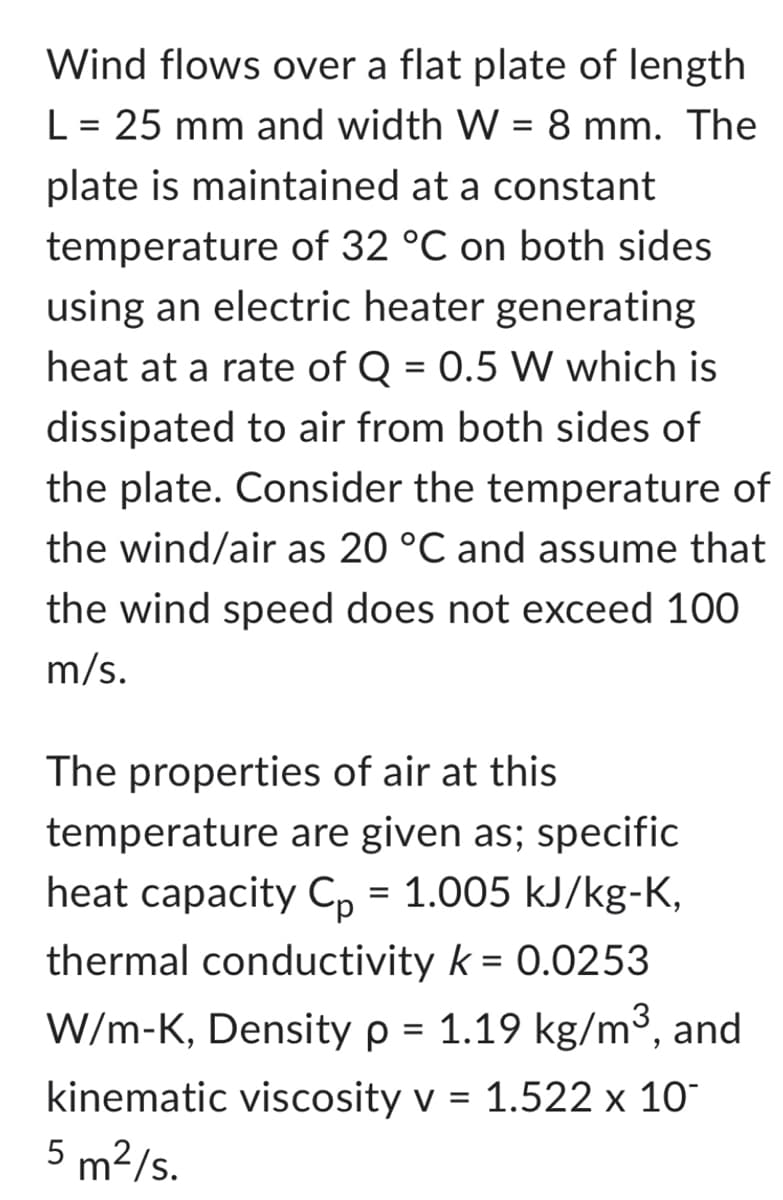Wind flows over a flat plate of length L = 25 mm and width W = 8 mm. The plate is maintained at a constant temperature of 32 °C on both sides using an electric heater generating heat at a rate of Q = 0.5 W which is dissipated to air from both sides of the plate. Consider the temperature of the wind/air as 20 °C and assume that the wind speed does not exceed 100 m/s. The properties of air at this temperature are given as; specific heat capacity Cp = 1.005 kJ/kg-K, thermal conductivity k = 0.0253 W/m-K, Density p = 1.19 kg/m3³, and kinematic viscosity v = 1.522 x 10- 5 m²/s.
Wind flows over a flat plate of length L = 25 mm and width W = 8 mm. The plate is maintained at a constant temperature of 32 °C on both sides using an electric heater generating heat at a rate of Q = 0.5 W which is dissipated to air from both sides of the plate. Consider the temperature of the wind/air as 20 °C and assume that the wind speed does not exceed 100 m/s. The properties of air at this temperature are given as; specific heat capacity Cp = 1.005 kJ/kg-K, thermal conductivity k = 0.0253 W/m-K, Density p = 1.19 kg/m3³, and kinematic viscosity v = 1.522 x 10- 5 m²/s.
Principles of Heat Transfer (Activate Learning with these NEW titles from Engineering!)
8th Edition
ISBN:9781305387102
Author:Kreith, Frank; Manglik, Raj M.
Publisher:Kreith, Frank; Manglik, Raj M.
Chapter5: Analysis Of Convection Heat Transfer
Section: Chapter Questions
Problem 5.24P: Engine oil at 100C flows over and parallel to a flat surface at a velocity of 3 m/s. Calculate the...
Related questions
Question

Transcribed Image Text:Wind flows over a flat plate of length
L = 25 mm and width W = 8 mm. The
plate is maintained at a constant
temperature of 32 °C on both sides
using an electric heater generating
heat at a rate of Q = 0.5 W which is
dissipated to air from both sides of
the plate. Consider the temperature of
the wind/air as 20 °C and assume that
the wind speed does not exceed 100
m/s.
The properties of air at this
temperature are given as; specific
heat capacity Cp = 1.005 kJ/kg-K,
thermal conductivity k = 0.0253
W/m-K, Density p = 1.19 kg/m³, and
kinematic viscosity v = 1.522 x 10
5 m²/s.

Transcribed Image Text:If Prandtl number, Pr= 0.72,
determine the average Nusselt
number.
Expert Solution
This question has been solved!
Explore an expertly crafted, step-by-step solution for a thorough understanding of key concepts.
Step by step
Solved in 2 steps with 2 images

Knowledge Booster
Learn more about
Need a deep-dive on the concept behind this application? Look no further. Learn more about this topic, mechanical-engineering and related others by exploring similar questions and additional content below.Recommended textbooks for you

Principles of Heat Transfer (Activate Learning wi…
Mechanical Engineering
ISBN:
9781305387102
Author:
Kreith, Frank; Manglik, Raj M.
Publisher:
Cengage Learning

Principles of Heat Transfer (Activate Learning wi…
Mechanical Engineering
ISBN:
9781305387102
Author:
Kreith, Frank; Manglik, Raj M.
Publisher:
Cengage Learning